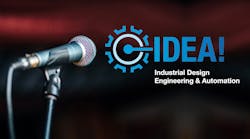The intersection between motion control and automation was among the topics covered at the Industrial Design, Engineering & Automation (IDEA!) Conference, held in conjunction with the M& T Conference Nov. 9-11 in Cleveland. Both conferences were presented by Endeavor Business Media.
The M&T Conference’s goal was to help manufacturing executives improve their firm’s operational efficiencies and product quality despite the constant of change. The three-day event featured an executive conference and two days of seminars focused on improving productivity, safety and operational efficiency.
Among the speakers on the first day of the IDEA! Conference was Richard Vaughn, automation engineering manager for Bosch Rexroth Corp. His presentation, “Smart Linear Actuators – Another Value Proposition for Factory Automation,” focused on mechatronics, the marriage of electrical and electronic technologies with mechanical components and assemblies for linear motion and automation. He pointed out how actuators are getting smarter and why that makes them even better value propositions for factory automation.
The first day of the IDEA! Conference also featured the announcement of the 2021 IDEA! Awards, jointly presented by Hydraulics & Pneumatics and Machine Design. Branson GMX 20DP ultrasonic spot welder received the Big IDEA! Award, given to the product that received the most votes among all entries. The GMX 20DP has a durable, reliable mechanical design and can monitor its own performance in creating precise welds on thin, fragile nonferrous foils and films. This will make it useful for making lighter, more “energy-dense” battery cells and packs that deliver more power per pound.
Other highlights on day one included the IDEA! Conference keynote presentation from Billy Taylor, CEO, LinkedXK, talking about “Driving Excellence Through Diversity and Inclusion.” It gave attendees ideas on how to give a company a diverse and inclusive culture that encourages communication and cooperation throughout the company. He cited the advantages of diversity and offered advice on how to get companies on the road to enlightened and profitable treatment of employees and in hiring practices.
Next up was Scott Dixon, director of Digital Manufacturing at EY, discussing the “Digital Transformation and the Factory of the Future.” He explained how the Factory of the Future concept will help manufacturers prepare for the future changes, whether expected or not (like COVID), and achieving success despite those changes.
The sessions ended on Wednesday with Mo Abuali, a partner at IoTco LLC, talking about IoT and Industry 4.0 and how they are working “Toward Zero Downtime, Zero-Defect Manufacturing.” He gave attendees ideas and approaches for why to get involved in IoT/Industry 4.0 and how to get started. He also outlined why artificial intelligence (AI) and predictive analytics are competitively necessary for IoT and Industry 4.0.
Abuali also gave a quick synopsis of several case histories of companies adopting innovative mechatronics and the rewards they reaped. His advice to companies looking to jump on the IoT/Industry 4.0 bandwagon: “Think big, act small and keep an eye on ROI.”
Nov. 11’s presentations started with Aaron Lichtig, VP of marketing at Xometry talking about how to “Digitize Your Manufacturing Process to Stay Ahead of the Competition.” He also explained “Manufacturing as a Service” (MaaS), and how it can help companies succeed. In MaaS, a firm like Xometry acts as a networked middleman, connecting people and companies who want to have parts made but lack the equipment or expertise with shops that have the capability and capacity to make them.
The conferences wrapped up with Jeff Christensen, vice president of product, Seegrid, explaining “The Keys to Building a Successful Supply Chain with Mobile Automation.” It gave attendees a look at how to define measurements of success metrics and to use data for generating a strong ROI today while preparing for tomorrow.
He also focused on one aspect of automation: electric vehicles that transported parts from one part of a factory to another. He noted that “Automation is hardly new, but it is very different from what it was 20 years ago. But the question for companies remains the same: Are you applying it in the right place?”


